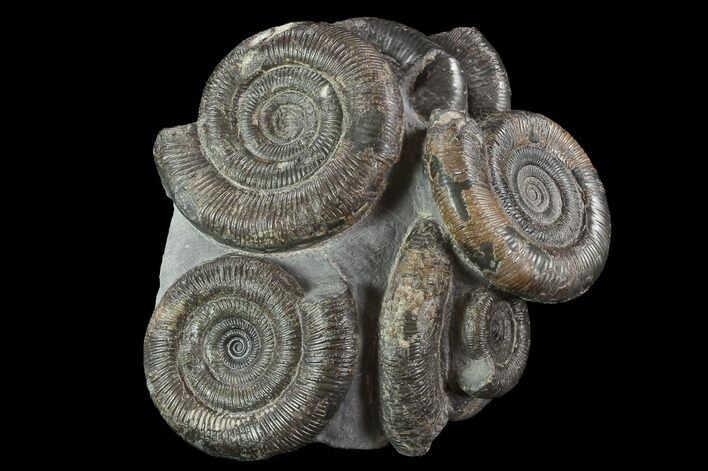This Specimen has been sold.
5.1" Dactylioceras Ammonite Cluster - Rare Occurrence
This is a cluster of Dactylioceras (Orthodactylites) tenuicostatum ammonites from the Somerset, England. The ammonites are Lower Jurassic (180 Million Years Old) in age and preserved in a cluster. There are seven complete ammonites in this cluster and the rock has been prepped in an artistic fashion that allows for aesthetic presentation of the ammonites. The rock matrix has been cut flat so the specimen sits nicely on a flat surface. Typically these are just found as single ammonites in the concretions so a cluster like this is extremely rare.
About Ammonites
Ammonites were ancient marine cephalopods, similar to today's squids and octopuses, but with a defining feature: their distinctive, tightly coiled spiral shells. These shells, resembling those of modern nautiluses, served as both a protective home and a buoyancy aid, allowing ammonites to navigate the prehistoric seas with ease. First emerging around 240 million years ago in the Triassic Period, ammonites thrived for over 175 million years, adapting through numerous forms and sizes. As predatory creatures, they likely fed on smaller marine organisms, using their tentacles to capture prey. However, their long reign came to an end 65 million years ago at the close of the Cretaceous, coinciding with the mass extinction event that also eliminated the dinosaurs.
Ammonites were ancient marine cephalopods, similar to today's squids and octopuses, but with a defining feature: their distinctive, tightly coiled spiral shells. These shells, resembling those of modern nautiluses, served as both a protective home and a buoyancy aid, allowing ammonites to navigate the prehistoric seas with ease. First emerging around 240 million years ago in the Triassic Period, ammonites thrived for over 175 million years, adapting through numerous forms and sizes. As predatory creatures, they likely fed on smaller marine organisms, using their tentacles to capture prey. However, their long reign came to an end 65 million years ago at the close of the Cretaceous, coinciding with the mass extinction event that also eliminated the dinosaurs.
SPECIES
Dactylioceras
LOCATION
Seavington, St. Micheal, Illminster, Somerset, England
FORMATION
The Grey Shales
SIZE
Cluster is 5.1 x 5.1 x 3", largest ammonite 2.85" wide
CATEGORY
SUB CATEGORY
ITEM
#93909
We guarantee the authenticity of all of our specimens.
 Reviews
Reviews















